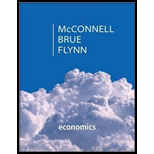
Sub part (a):
Accounting and economic profit before and after the tax.
Sub part (a):
Answer to Problem 5P
Total explicit cost is $220,000: Accounting profit with low income is -$20,000 and with high profit is $180,000.
Explanation of Solution
Current earning per worker is $60,000. She would prefer to become an entrepreneur unless she earns an accounting profit of at least $60,000. As an entrepreneur, she is planning to open a small grocery store. She has an annual cost of $150,000 for labor, $40,000 for rent and $30,000 for equipments.
There is a one-half probability that the revenue equals to $200,000 (low revenue) and one-half probability that revenue equals to $400,000.
Total explicit cost can be calculated as follows.
Total explicit cost is $220,000.
Accounting profit with low revenue can be calculated as follows.
Accounting profit with low income is -$20.000.
Accounting profit with low revenue can be calculated as follows.
Accounting profit with high income is $180.000.
Concept introduction:
Accounting profit: Accounting profit refers to the excess revenue after subtracting the total cost from the total revenue.
Economic profit: Economic profit refers to the additional profit after subtracting the
Sub part (b):
Expected average revenue, Accounting profit and economic profit.
Sub part (b):
Answer to Problem 5P
Expected average revenue is $300,000: Accounting profit is $80,000 and Economic profit is $20,000.
Explanation of Solution
Expected average revenue can be calculated as follows
Expected average revenue is $300,000.
Expected accounting profit can be calculated as follows.
Expected accounting profit is $80,000.
Expected economic profit can be calculated as follows.
Expected economic profit is $20,000. The person would quit the job since there is a positive economic profit.
Sub part (c):
Accounting profit after tax, and expected profit.
Sub part (c):
Answer to Problem 5P
Accounting profit after tax is $135,000: Expected profit is $57,500 and -$2,500.
Explanation of Solution
There is an accounting loss with the low income. Thus, the accounting profit with the low income does not change.
Accounting profit with high income after tax can be calculated as follows.
Accounting profit after tax is $135,000.
Expected accounting profit after tax can be calculated as follows.
Expected accounting profit is $57,500.
Expected economic profit after tax can be calculated as follows.
Expected economic profit is -$2,500. Since the expected economic profit is negative, the person would not quit the job.
Sub part (d):
Whether the individual is indifferent or not between Accounting profit after tax and current earnings.
Sub part (d):
Explanation of Solution
The accounting profit after tax in case of average revenue is $60,000, which is equal to the current earnings. Therefore, she is indifferent about her decision to quit the job or not. So, some people would prefer to go for entrepreneurship and other will stay as workers.
Want to see more full solutions like this?
Chapter 18 Solutions
ECONOMICS W/CONNECT+20 >C<
- Critically analyse the five (5) characteristics of Ubuntu and provide examples of how they apply to the National Health Insurance (NHI) in South Africa.arrow_forwardCritically analyse the five (5) characteristics of Ubuntu and provide examples of how they apply to the National Health Insurance (NHI) in South Africa.arrow_forwardOutline the nine (9) consumer rights as specified in the Consumer Rights Act in South Africa.arrow_forward
- In what ways could you show the attractiveness of Philippines in the form of videos/campaigns to foreign investors? Cite 10 examples.arrow_forwardExplain the following terms and provide an example for each term: • Corruption • Fraud • Briberyarrow_forwardIn what ways could you show the attractiveness of a country in the form of videos/campaigns?arrow_forward
 Managerial Economics: A Problem Solving ApproachEconomicsISBN:9781337106665Author:Luke M. Froeb, Brian T. McCann, Michael R. Ward, Mike ShorPublisher:Cengage Learning
Managerial Economics: A Problem Solving ApproachEconomicsISBN:9781337106665Author:Luke M. Froeb, Brian T. McCann, Michael R. Ward, Mike ShorPublisher:Cengage Learning Managerial Economics: Applications, Strategies an...EconomicsISBN:9781305506381Author:James R. McGuigan, R. Charles Moyer, Frederick H.deB. HarrisPublisher:Cengage Learning
Managerial Economics: Applications, Strategies an...EconomicsISBN:9781305506381Author:James R. McGuigan, R. Charles Moyer, Frederick H.deB. HarrisPublisher:Cengage Learning Economics (MindTap Course List)EconomicsISBN:9781337617383Author:Roger A. ArnoldPublisher:Cengage Learning
Economics (MindTap Course List)EconomicsISBN:9781337617383Author:Roger A. ArnoldPublisher:Cengage Learning







